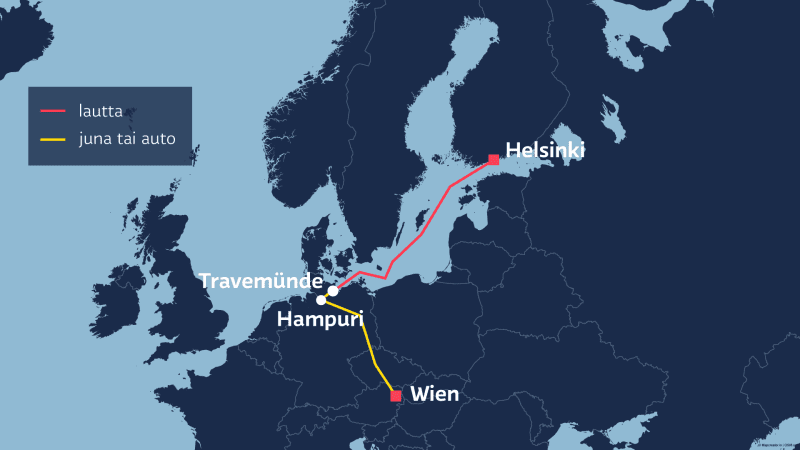From southern Finland, the road to Central Europe goes through Stockholm, Tallinn or Travemünde. Having lived in Central Europe for six years, Sunna Kokkone has experience on every route.
When traveling by land, you can enjoy the scenery, and the tourist sees more than just the plane’s cabin.
Traveling by land is also an environmentally friendly way to travel. It is estimated that the train produces at least ten times less emissions than what is produced when traveling by air.
Buying a plane ticket to Central Europe has been made easy, and the vacationer does not have to worry about choosing a travel route. It is different for those traveling by land.
Although traveling overland requires a little planning, it’s easy to get started. Information and tips can be obtained, for example, from the website Maatapitkin.net, which has links to the ticket sales websites of different countries’ train companies.
Despite the links and tips, the choice of route remains on the shoulders of the passenger.
From Vaasa to Umeå, from Tornio to Lulea
There are several ways to get to central Europe from Finland, and there are also different options for traveling to Stockholm.
For those living in the Vaasa region, a good option is to go by ship to Umeå, and continue from there by day or night train to Stockholm.
From Oulu and further north you can travel by train or bus to Tornio, and continue from there by bus to the Swedish side to the Haaparanta-Tornio travel center, from where the journey continues by bus to Lulea. The rest of the journey to Stockholm is by train. You can also take a train from Haaparana to, for example, Boden, where you can change to a night train to Stockholm.
There are three different routes from southern Finland: via Stockholm, Tallinn and Travemünde.

Route 1: From Helsinki or Turku to Stockholm
Stockholm can also be reached from Helsinki, but Sunna Kokkonen usually travels via Turku.
From Stockholm, the journey continues via Copenhagen to Hamburg, Germany. If you leave Turku on the evening ship, you can get to Hamburg by the next evening. Of course, between Stockholm and Hamburg you can also spend the night in, say, Copenhagen or some small Danish town.
– In terms of landscapes, the Swedish route does not have much to offer Finns, because the landscapes look pretty much the same as in southern Finland, Sunna Kokkonen estimates.\n Another disadvantage of the Stockholm route is that the trains are often sold out, so you should reserve your seats in time.

Route 2: From Helsinki via Tallinn to Warsaw
Another route towards Central Europe goes through Tallinn to Warsaw, Poland.
After the ship trip from Tallinn, the fastest and simplest choice towards Central Europe is the bus, which takes around seventeen hours at its fastest. Of course, you can easily cut the Tallinn-Warsaw distance into two stages, and stop in Kaunas, for example.\n And if you are wondering about taking a bus, you can also continue the journey from Lithuania to Warsaw by rail.
– The Baltic route will probably be the cheapest, as food and possible overnight stays are significantly cheaper than, for example, via Denmark, Sunna Kokkonen calculates.

Route 3: From Helsinki by ship to Travemünde
The third route used by Sunna Kokkonen goes through Travemünde, Germany. For those traveling in a shared cabin, this route is probably more affordable than traveling via Stockholm.
The boat trip from Helsinki to Travemünde takes about thirty hours. You can get away from your everyday life for a while, and the trip includes a variety of seascapes.
The ship arrives in Germany in the evening. When planning your travel schedule, you should take into account that the trip also includes an overnight stay somewhere near Lübeck.
The Travemünde route is Sunna Kokkonen’s personal favorite.
– It’s great when you can get so close to the harbor by metro. You don’t need to sit still on the ship either, instead you can spend time in, say, the sauna or the gym, Sunna Kokkonen sums up.
*Sunna Kokkonen* *blog post**.*
What are your experiences of traveling overland? The discussion on the topic is open until Wednesday, May 3. until 11 p.m.
